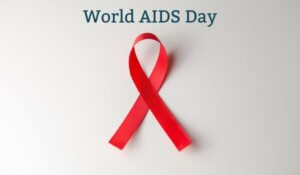 On December 1st, people around the world come together for World AIDS Day. This yearly event reminds everyone to keep working hard to stop new HIV/AIDS infections and ensure that everyone with HIV/AIDS gets the care they need. 2024 marks the 37th World AIDS Day with the theme “Working Together: Keep Up and Speed Up HIV Progress.“
On December 1st, people around the world come together for World AIDS Day. This yearly event reminds everyone to keep working hard to stop new HIV/AIDS infections and ensure that everyone with HIV/AIDS gets the care they need. 2024 marks the 37th World AIDS Day with the theme “Working Together: Keep Up and Speed Up HIV Progress.“
This theme shows the U.S. government’s commitment to using the progress made in global and domestic HIV/AIDS programs over the past 40 years to make sure no communities are left out. They are also working to improve and change programs based on new scientific discoveries and lessons learned from past projects.
Some examples include the President’s Emergency Plan For AIDS Relief’s (PEPFAR) new plan to ensure equal HIV/AIDS services for key groups, the introduction of long-acting, injectable pre-exposure prophylaxis (PrEP) in the U.S. and worldwide, and a focus on removing barriers that stop people from getting HIV testing, prevention, and treatment, like lack of housing or mental health.
Latest Medical Advancements for HIV/AIDS
The first steps towards treatment for HIV infections came with the development of antiretroviral therapy (ART). ART involves taking an HIV treatment regimen) every day. The main goal of HIV treatment is to reduce a person’s viral load to a level of HIV in the blood that is too low to be detected by a viral load test. This has dual benefits. Firstly, having lower levels of the virus in the body gives the immune system a chance to recover and fight off infections and HIV-related cancers. Secondly, there is effectively no risk of transmitting HIV to another person.
A few examples of ART drugs are:
- Biktarvy, which combines three of the most important classes of HIV treatment: an integrase strand transfer inhibitor (INSTI), a nucleoside reverse transcriptase inhibitor (NRTI), and a nucleotide reverse transcriptase inhibitor (NtRTI).
- Trizivir, which combines three NRTI drugs (lamivudine, zidovudine and abacavir),
- Ziagen, which delivers abacavir, a form of NRTI especially useful because it can also be used during childbirth to keep the mother from passing HIV to her baby.
What is PrEP?
Pre-exposure prophylaxis (PrEP) is a medication that people without HIV can take to reduce their risk of getting the virus. It is suggested for individuals who might get HIV, such as those with an HIV-positive partner not receiving treatment or those who are sexually active without using condoms. A doctor can provide a prescription for PrEP. A PrEP pill such as Truvada is generally taken every day, but in some situations, taking it less often might still work. It’s important to discuss personal situations with a doctor to find the most suitable PrEP plan.
Why is World AIDS Day Important?
It is important to keep reminding everyone that HIV and AIDS are still serious health issues. We need to listen to and focus on people living with HIV/AIDS and work with more partners to address this in order to reach the UNAIDS goals of 95% testing, treatment, and viral suppression. To move faster toward these goals, we must continue the progress PEPFAR has made over 21 years in providing treatment and preventing HIV worldwide.
The Power of Collective Action on World AIDS Day
Everyone should remember the millions who have died from HIV/AIDS. To honor them, we must work together to improve and expand programs that help communities most affected by HIV/AIDS and other related issues like sexually transmitted infections, mental health problems, substance abuse, and hepatitis.
The federal government is working with communities and people who have firsthand experience to improve funding and research. Since PEPFAR began in 2003, it has saved over 25 million lives and helped more than 5.5 million babies be born without HIV in 55 countries. In the 2023 fiscal year, PEPFAR helped nearly 20.5 million people get lifesaving treatment and enrolled almost 2 million people in PrEP.
What exactly are PREPFAR’s Aims?
PEPFAR aims to:
- Stop HIV/AIDS from being a public health problem by 2030.
- Encourage political support, funding, and leadership to achieve health security and tackle health threats like HIV/AIDS.
- Strengthen global cooperation and readiness through diplomacy to guard against health security risks.
- Equip diplomats to make global health security a main part of U.S. foreign policy.
Addressing stigmas around HIV/AIDS
While all the government initiatives are making great headway, and much has changed since the 1980’s, there are still a lot of myths surrounding HIV and AIDS. One of the best ways to be an ally on World AIDS Day is to look into these and challenge them within ourselves and also within others.
What are the stigmas around HIV/AIDS?
A stigma is a negative belief or prejudice about people with a particular attribute, like a physical or mental health issue. They can come from oneself, other individuals, or institutions and often result in unfair treatment of those with that particular feature.
Negative views about people with HIV started in the 1980s when the virus first caused the HIV and AIDS crisis in the United States. Wrong information about HIV/AIDS made people believe things about those with the virus that weren’t true.
Some of the more common stigmas include:
HIV is a death sentence: People often think HIV is a “death sentence,” but this isn’t true anymore. Since the first HIV drug was approved in 1987, treatments have gotten much better. New drugs have significantly extended the life expectancies of people with HIV.
Since the 1980s, diagnosing and treating HIV has gotten a lot better. However, many people worldwide are still affected by it. The Centers for Disease Control and Prevention (CDC) says that HIV remains a major health issue all over the world.
HIV only affects homosexual men: Although some groups have a higher risk of getting HIV/AIDS, anyone can catch the virus, no matter their gender, ethnicity, or sexual orientation. HIV can spread not only through sexual contact but also by sharing needles or drug equipment, and it can be passed from mother to baby.
HIV can be spread by touching an infected person: HIV cannot be spread just by touching. It is only transmitted via blood, semen and pre-seminal fluid, rectal and vaginal fluids, and breast milk. HIV is not spread by shaking hands, touching, or simply being near someone who has the virus.
How do these negative viewpoints affect people with HIV/AIDS?
Jobs: People with HIV may need more healthcare, like taking time off work for doctor visits, which can risk their jobs. Sometimes, they might face unfair treatment at work due to prejudice.
Housing: Finding good housing can be tough if they can’t work because of discrimination. Landlords might also discriminate, and neighbors or housemates might be unfair to them.
Healthcare: Shame from HIV stigma can stop people from getting the treatment they need. If healthcare workers don’t fully understand HIV, it can add to the burden.
Relationships: Prejudice can lead to gossip, rejection, bullying, and sometimes even violence. Myths about HIV can make intimacy challenging for those living with the virus.
This can greatly harm the mental health of people living with HIV/AIDS. It can affect various parts of their mental well-being, such as self-esteem and levels of depression and anxiety.
How can I get involved?
Everyone can help fight discrimination against people living with HIV and AIDS by changing how they and others see HIV. Here are some ideas to begin with.
Take some time to read current facts and statistics about HIV instead of relying on old information about what it is and who it affects. Listen to stories from people living with HIV to understand how they can be supported both personally and in their communities.
When talking about HIV, it’s important to use mindful language to help reduce stigma. Avoid terms like “HIV-infected,” “unsafe,” and “high-risk,” as they can be negative. Instead, use neutral or inclusive words, such as “people living with HIV/AIDS.”
Take a stand against discrimination. Discrimination can greatly affect the lives of people with HIV, so it’s crucial for everyone to speak out against it. Standing up might involve speaking out when someone makes a hurtful comment or reporting discrimination to the right authorities.
Joining HIV/AIDS organizations is also important. These groups, both national and local, educate people about HIV facts and statistics. By volunteering, donating, or raising awareness, individuals support ongoing efforts to help people worldwide who are living with HIV and AIDS on World AIDS Day and every day.
















